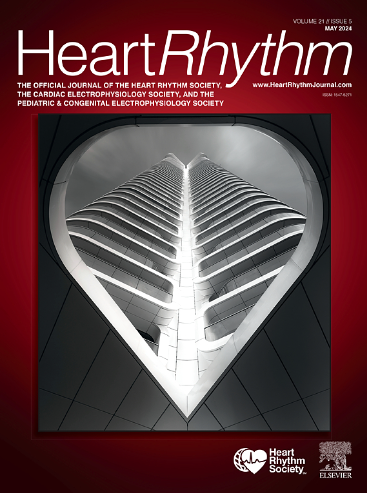A multiparametric heart failure score at baseline is associated with long-term outcome in patients with remotely monitored implantable cardioverter-defibrillators: A pooled analysis of 9 clinical trials
IF 5.6
2区 医学
Q1 CARDIAC & CARDIOVASCULAR SYSTEMS
引用次数: 0
Abstract
Background
To predict worsening heart failure hospitalizations (WHFHs), the HeartInsight multiparametric algorithm calculates a heart failure (HF) Score based on temporal trends of physiologic parameters obtained through automatic daily remote monitoring of implantable cardioverter-defibrillators (ICDs).
Objective
We studied the association of the baseline HF Score, determined at algorithm activation, with long-term patient outcomes.
Methods
Data from 9 clinical trials were pooled, including 1841 ICD patients with a preimplantation ejection fraction ≤35%, New York Heart Association class II/III, and no long-standing atrial fibrillation. The primary end point was a composite of death or WHFH.
Results
After a median follow-up of 631 days (interquartile range, 385–865 days), there were 243 WHFHs in 173 patients (9.4%) and 122 deaths (6.6%), 52 of which (42.6%) were cardiovascular. The primary end point occurred in 265 patients (14.4%). A multivariable time-to-first-event analysis showed that a high baseline HF Score (>23, as determined by a time-dependent receiver operating characteristics curve analysis) was significantly associated with the occurrence of the primary end point (adjusted hazard ratio [HR], 2.05; 95% confidence interval [CI], 1.54–2.71; P < .0001), all-cause death (HR, 2.37; CI, 1.56–3.58; P < .0001), cardiovascular death (HR, 2.19; CI, 1.14–4.22; P = .019), and WHFH (HR, 1.91; CI, 1.35–2.71; P = .0003). In a hierarchical event analysis of all-cause death as the outcome with highest priority and WHFHs as repeated event outcomes, the win ratio was 2.47 (CI, 1.89–3.24; P < .0001).
Conclusion
Based on a retrospective analysis of clinical trial data with adjudicated events, baseline HF Score derived from device-monitored variables was able to stratify patients at higher long-term risk of death or WHFH.

基线多参数心衰评分与远程监控植入式心律转复除颤器患者的长期预后有关:九项临床试验的汇总分析。
背景:为了预测心力衰竭住院治疗(WHFHs)的恶化情况,HeartInsight 多参数算法根据植入式心律转复除颤器(ICD)每日自动远程监测获得的生理参数的时间趋势计算心力衰竭(HF)评分:我们研究了算法启动时确定的基线高频评分(BHFScore)与患者长期预后的关系:汇总了九项临床试验的数据,其中包括 1841 名植入前射血分数≤35%、NYHA 分级为 II/III 级、无长期房颤的 ICD 患者。主要终点为死亡或 WHFH:中位随访631天(四分位间范围385-865)后,173名患者(9.4%)出现243例WHFH,122例死亡(6.6%),其中52例(42.6%)为心血管死亡。265名患者(14.4%)出现了主要终点。首次事件发生时间的多变量分析表明,BHFS评分高(>23,由时间依赖性接收器操作特征曲线分析确定)与主要终点的发生显著相关(调整后危险比[HR],2.05;95%置信区间[CI],1.54-2.71;P结论:基于对已判定事件的临床试验数据的回顾性分析,从设备监测变量得出的基线高频评分能够对死亡或 WHFH 长期风险较高的患者进行分层。
本文章由计算机程序翻译,如有差异,请以英文原文为准。
求助全文
约1分钟内获得全文
求助全文
来源期刊

Heart rhythm
医学-心血管系统
CiteScore
10.50
自引率
5.50%
发文量
1465
审稿时长
24 days
期刊介绍:
HeartRhythm, the official Journal of the Heart Rhythm Society and the Cardiac Electrophysiology Society, is a unique journal for fundamental discovery and clinical applicability.
HeartRhythm integrates the entire cardiac electrophysiology (EP) community from basic and clinical academic researchers, private practitioners, engineers, allied professionals, industry, and trainees, all of whom are vital and interdependent members of our EP community.
The Heart Rhythm Society is the international leader in science, education, and advocacy for cardiac arrhythmia professionals and patients, and the primary information resource on heart rhythm disorders. Its mission is to improve the care of patients by promoting research, education, and optimal health care policies and standards.
 求助内容:
求助内容: 应助结果提醒方式:
应助结果提醒方式:


